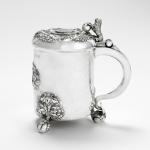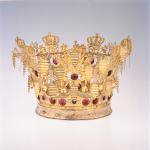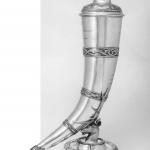The Silver Tax of 1816
Nation Building through Volunteerism and Force. How is value created and recreated throughout history?
200 years ago Norway established its own national bank. The starting capital was raised through what was popularly called ‘the silver tax’. Norway’s citizens contributed both silver objects and coins.
The transformation of value – from objects to money – has now gone further, resulting in today’s virtual economy. People no longer fill treasure chests with precious metals, but silver objects do still have special meaning in many a Norwegian’s life.
The exhibition ‘The Silver Tax of 1816’ marks the 200th anniversary of the founding of Norway’s central bank, Norges Bank. It gives the public insight into different forms of value: the silver’s value as a metal, and the symbolic value of silver objects. The exhibition also addresses critical issues related to our confidence in means of payment and today’s virtual economy.
To raise the capital needed to establish the bank, silver was collected from ordinary citizens, first in the form of voluntary subscription (shares), eventually through compulsory taxation. In Bergen, 876 people contributed. Through a selection of personal objects such as silverware, jewellery and bunad silver (worn with the national costume) from the collections of KODE and the University Museum of Bergen, the public can learn about seven local citizens who made large and small contributions to help Norway in a time of deep economic crisis. These are the business magnates August Konow and Herman D. Janson, the teachers at the Latin school F.C.H. Arentz and Lyder Sagen, the business women Karen Ameln and Else Marie von Tangen, and Norway’s parliament speaker at the time, W.F.K. Christie.
In conjunction with the exhibition, KODE will organise several debates that challenge our understanding of what is considered valuable in Norway today, not only in the fields of art and culture but in the social and political spheres. How is value created and transformed throughout history?
Bergen Collaboration
‘The Silver Tax of 1816’ is part of Norges Bank’s bicentenary celebrations and is produced by KODE, in collaboration with the University Museum of Bergen and Bergen City Museum.
The University of Bergen has commissioned a series of articles which will be published in connection with the exhibition. The authors shed light on different aspects of the silver tax and its influence on Bergen’s society and Norwegian society as a whole. Bergen City Museum has developed a mobile app which takes you on a dramatised walking tour to some of the addresses of those who paid the silver tax in 1816.
- 28 Sep 2016 to 29 Jan 2017
- Kode 2
- NOK 100/50/0 *
* Adults: NOK 100-, Students: NOK 50-, Children (0-16 yrs.): Free. Free admission with the Bergen card. The ticket gives admission to all exhibitions at KODE for two days



